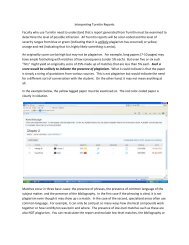The Renaissance Development of the Scientific Illustration - Winthrop
The Renaissance Development of the Scientific Illustration - Winthrop
The Renaissance Development of the Scientific Illustration - Winthrop
You also want an ePaper? Increase the reach of your titles
YUMPU automatically turns print PDFs into web optimized ePapers that Google loves.
Page <strong>of</strong> Drawings from Taccola, De ingeniis, Cod. Lat. 197, Bayrische Staatsbiblio<strong>the</strong>k,Munich.Taccola's ideas and many <strong>of</strong> his original drawings passed into <strong>the</strong> hands <strong>of</strong>his fellow Sienese Francesco di Giorgio Martini during <strong>the</strong> second half <strong>of</strong> <strong>the</strong>fifteenth century. <strong>The</strong> latter had also read <strong>the</strong> recently available ten books onarchitecture by <strong>the</strong> ancient, Roman Vitruvius. It <strong>the</strong>refore occurred toFrancesco di Giorgio to write an even more ambitious treatise than Taccola's,covering not only military and civil engineering but containing designs forclassical-style buildings.'' He was also a better artist than Taccola; in fact, hewas a practicing painter with a distinguished oeuvre, many examples <strong>of</strong> whichare known and admired today. <strong>The</strong> manuscript pages shown here were writtenand illustrated by Francesco di Giorgio about 1475. <strong>The</strong> former is a descriptionand reconstruction <strong>of</strong> a Roman bath. <strong>The</strong> artist neatly applied Taccola's 'trans-Page <strong>of</strong> DrawingCod. Ashb. 361,.observe in <strong>the</strong>












